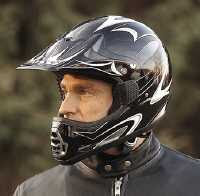Whether you want a performance chip that you can just plug in and forget about, or one that you can constantly tinker with to find your perfect settings, AutoAnything has the right electrical gear for you. We have three different styles of performance chips to choose from, each with their own unique characteristics and capabilities. However, for all their differences, the one thing they have in common is the power to propel your vehicle's performance to unbelievable heights.
3 fundamental types of performance chips
Control Modules
A control module plugs directly into your under-the-hood electrical system, standing right in between the data from your various sensors and the computer. The module intercepts the data before it has a chance to reach the onboard computer. Then, it analyses the information, determines the proper adjustments to the air/fuel ratio, ignition timing and other key functions, and then sends commands to the onboard computer. A control module delivers accurate, immediate tuning for your engine because it is always plugged in and constantly reading and interpreting data from your sensors.
Each control module is custom-programmed to maximize the output and efficiency of your vehicle's specific year, make and model, taking into consideration engine size, transmission type and even your stock tire size. What's more, many control modules come in different power levels, or stages. That way, you can choose the perfect amount of power for your unique driving habits.
Many of the control modules for diesel rigs have optional in-cab monitors that display up to the second readings of such critical engine information as turbo boost, engine gas temperature and RPMs. Some even display your 0-60 acceleration and quarter mile time, and give you on-the-fly control of different settings. For the best results, you will want to use a higher grade fuel with more octanes, like 91 or higher.
Installing a control module is simple and should not take more than 15 minutes. They have a built-in, heat-shielded wiring harness that plugs directly into your onboard computer, so there's absolutely no soldering, splicing or drilling required. After all the wires are connected, you never have to worry about adjusting the module ever again, unless you would like to return to your factory settings.
Power Programmers
Like control modules, power programmers reconfigure your vehicle's onboard computer to perform at peak levels, but they operate differently. Rather than being permanently installed into your electrical system, power programmers are plug-n-play devices.
Before hitting the road, you connect it to your OBD-II Port, which is handily located right under your dashboard. You will then answer a number of questions about your vehicle, any modifications you have made and what level of power you want. Based on how you respond to the questions, the power programmer then uploads a new set of operating instructions to your vehicle's computer. The new operating program only has to be uploaded once, so you can pack away your power programmer or experiment with some of the other settings and modes. Best of all, the whole process only takes about 10 minutes, and the only tools you'll need are your own two hands.
The advantage of the power programmer is that you have greater control over the tuning of your system. For example, you will be able to recalibrate your onboard computer to any changes in tire size, speed rating or even your rear end gear ratio. These changes dramatically affect your vehicle's performance, but your computer does know to recalculate unless you use a power programmer to communicate with it. Moreover, many of our power programmers let you tune your engine for regular octane usage instead of the usual 91 or higher fuel grade.
Engine Management Systems (EMS)
If you want total control of your vehicle's computer system, don't just reprogram it-replace it. An EMS is a complete substitution for your stock onboard computer, giving you virtually unlimited command over just about ever aspect of your vehicle's control system.
Engine management systems are designed to customize your car, truck, or SUV to your exact specifications. For those of us who know about the inner workings of your entire drive train, only an EMS gives you full control of every minute detail, from your air/fuel ratio and fuel injector control, to idle speed and nitrous (wet or dry) management.
You mount the EMS inside your engine compartment. Once it is secured, you simply unplug the wires from your old computer and plug them into the new one. Those wires sync your EMS with all of your vehicle's sensors, so it has an immediate connection to all the data from every critical part on your automobile. It uses the readings from your sensors to run your engine at its peek level. You can even plug your laptop into the EMS to view performance information and manipulate settings.
Application with your ride
Sure, a control module, power programmer or EMS unleashes huge gains in horsepower, torque and efficiency, but you are probably wondering how it actually works. For most performance parts, their purpose is obvious-more power. You can visualize and hear a hotrod exhaust system hard at work, and you can hold the pipes and headers right in your hands. A performance chip, on the other hand, exists in the invisible world of electrical pulses and binary codes.
zannel.com
Subscribe to:
Post Comments (Atom)

No comments:
Post a Comment